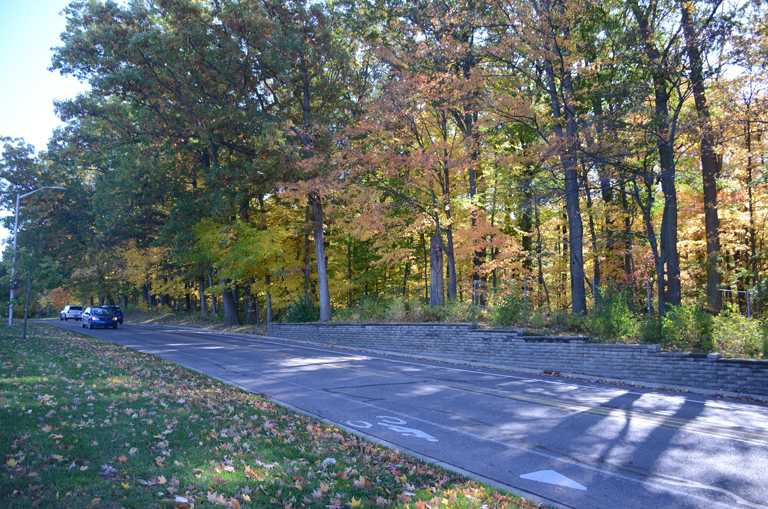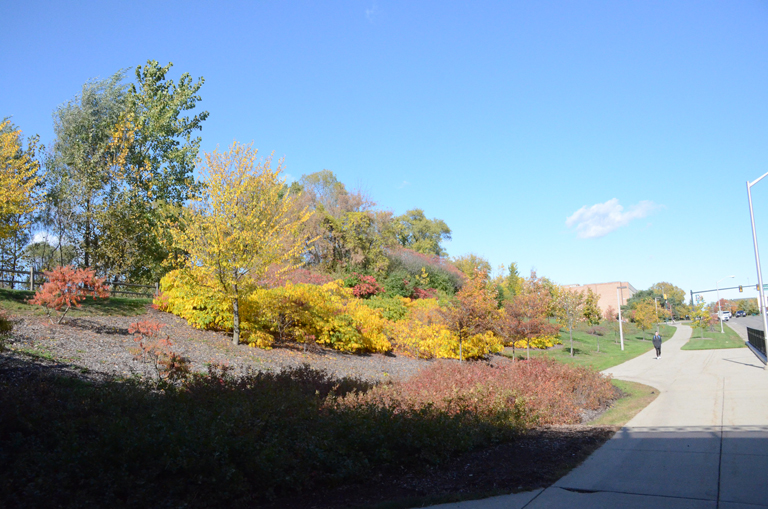- Comprehensive urban forestry planning can influence the everyday lives of citydwellers by reducing storm water runoff, decreasing wildfire risk and severity, reducing urban heat islands, decreasing utility costs, increasing economic growth, and providing clean drinking water.
- Urban trees also have the ability to sequester atmospheric carbon dioxide (CO2) and serve as long-term carbon sinks. However, cities seem to be lacking in language and planning to link together various mitigation and adaptation strategies specifically to sequester and store CO2 within urban trees.
- While there are examples of cities incorporating forest carbon storage and sequestration policies into their planning, these are limited, and often only in our largest cities. Many cities have excellent programming to encourage tree plantings and green space but are not quite comfortable taking a leap into climate mitigation claims and calculations. Here’s a look at what cities are doing.
- This post is a commentary. The views expressed are those of the author, not necessarily Mongabay.
After the United States pulled out of the 2016 Paris Climate Agreement, combating climate change at local scales in the U.S. has become increasingly important to meet greenhouse gas (GHG) emission reduction goals.
Luckily, cities and local municipalities are beginning to recognize the important linkages between urban resiliency, human well-being, and climate change mitigation and adaptation activities. They have important opportunities to leverage their urban forests to fight climate change.
There are plenty of examples of cities leading the way on climate by joining activities such as the C40 Cities for Climate Leadership Groups, US Climate Mayors, ICLEI Local Governments for Sustainability, Carbon Climate Registry, and the Under2 Coalition. Cities and municipalities already focus on GHG emission reductions, increasing green spaces, green building certification, green infrastructure development, the reduction of transportation emissions, increased energy efficiencies, energy saving initiatives, and smart city planning, and even carbon taxes in some cases. Using these tools, local governments and city planners can create resilient urban areas that can counteract the negative effects of climate change.
Another area where cities are increasingly enacting policies is by managing urban forests for climate. Comprehensive urban forestry planning can influence the everyday lives of citydwellers by reducing storm water runoff, decreasing wildfire risk and severity, reducing urban heat islands, decreasing utility costs, increasing economic growth, and providing clean drinking water.
Urban trees also have the ability to sequester atmospheric carbon dioxide (CO2) and serve as long-term carbon sinks. However, cities seem to be lacking in language and planning to link together various mitigation and adaptation strategies specifically to sequester and store CO2 within urban trees.

So, why aren’t more cities explicitly linking the CO2 sequestration benefits with their urban forests?
With varying city size and capacity, the answer is not simple. While there are examples of cities incorporating forest carbon storage and sequestration policies into their planning, these are limited, and often only in our largest cities. Many cities have excellent programming to encourage tree plantings and green space but are not quite comfortable taking a leap into climate mitigation claims and calculations.
There is no one size fits all strategy for cities to undertake climate mitigation activities. Local policy makers must identify and create specific local strategies that fit within a regional context, but expertise to do this can be lacking in terms of climate mitigation and adaptation. Studies have shown that organizing and coordinating between various stakeholders is quite difficult, especially when urban forests span multiple jurisdictions. Additionally, finding the political support to pass ordinances remains elusive even in places where public support for urban tree management is strong.
Insufficient funding and professional knowledge are probably the largest barriers preventing cities from accomplishing such a task. Upfront costs of training professional staff and establishing a network for monitoring and assessing urban forest health can quickly surpass the capabilities of local governments. Sustainable funding for management assistance and tree care remains a formidable obstacle, as well. Diversifying and securing stable sources of funding is needed to increase awareness in areas without proactive approaches to urban forest management.
Now, let’s look at what cities are doing:
Looking at urban forestry plans across the country, there are three main examples of ways cities use urban forestry to store more carbon: 1) tree plantings; 2) percent canopy cover targets; and 3) urban forest management strategies.

Tree plantings are the most common local policy that provides carbon storage. Cities across the US have programs to provide free trees, request plantings, access educational materials, and receive tree maintenance. Cities can see benefits such as being a part of programs through the U.S. Forest Service’s Urban and Community Forest Program or the Arbor Day Foundation’s Tree City USA. Examples of government-funded tree planting initiatives are Seattle, Washington; Sarasota, Florida; and San Jose, California.
Cities often target increasing tree canopy cover to reduce urban heat island temperatures or to reduce storm water runoff. However, increasing canopy cover provides additional benefits through carbon storage, sequestration, habitat derivation, and biodiversity. Cities such as Philadelphia, Pennsylvania; Columbus, Ohio; Orlando, Florida; and Long Beach, California have efforts underway to increase percent tree canopy cover. Many of these initiatives are aimed at increasing tree cover in lower-income urban areas, as these areas are disproportionately affected by tree loss and generally more likely to suffer the adverse effects of climate change.
The most progressive forest carbon policies are comprehensive urban forest management plans. San Francisco has implemented such a plan in three phases: Phase 1 focuses on the management of street trees to highlight their benefits (completed in 2014); Phase 2 focuses on a vision and strategy for trees in parks and opens spaces to address policy, management, and financing of park trees; and Phase 3 will develop recommendations for trees on private property and guidelines for green roofs and walls. According to its annual report, San Francisco’s urban forest stores 196,000 metric tons of carbon (MtC) and sequesters 5,200 MtC per year. Overall, the plan highlights that trees are valuable infrastructure to urban areas and necessary for ecological functions and benefits within urban settings.
While cities of all sizes have an opportunity to lead when it comes to combating climate change, plenty of challenges remain. With tight municipal budgets, funding for such initiatives remains a crucial challenge to achieving climate mitigation goals. Although long-term funding, like US Forest Service or non-profit grants, can be elusive, many municipalities can achieve promising outcomes with spurts of funds, for example for tree plantings and educational initiatives. Urban forests could receive financial support from linkages to carbon markets and other carbon project financing mechanisms, if they develop.
Overall, cities remain an important piece of the puzzle to meeting global climate change goals. As more cities begin to link their current climate change activities to the benefits of carbon sequestration and storage through the management of urban forests, the climate benefits provided by trees will only continue to increase.
We have an opportunity to boost understanding of climate mitigation and adaptation with tools and training so urban planners, foresters, officials, council members, and others are able to value and communicate climate mitigation benefits of forests. Programs such as Michigan State University’s Forest Carbon and Climate Program (where the authors work) and the Forest-Climate Working Group continue to educate future leaders, planners, and managers of urban forests to work towards climate change solutions.

CITATIONS
• Driscoll A.N., Ries, P.D., Tilt, H.J., Ganio, L.M. (2015). Needs and barriers to expanding urban forestry programs: An assessment of community officials and program managers in the Portland-Vancouver metropolitan region. 14(1):48-55. doi.org/10.1016/j.ufug.2014.11.004
• Elmqvist, T., Setälä, H., Handel, S. N., Van Der Ploeg, S., Aronson, J., Blignaut, J. N., … & De Groot, R. (2015). Benefits of restoring ecosystem services in urban areas. Current opinion in environmental sustainability, 14, 101-108. doi:10.1016/j.cosust.2015.05.001
• Escobedo, F. J., Kroeger, T., & Wagner, J. E. (2011). Urban forests and pollution mitigation: Analyzing ecosystem services and disservices. Environmental pollution, 159(8-9), 2078-2087. doi:10.1016/j.envpol.2011.01.010
• Haaland, C., & van den Bosch, C. K. (2015). Challenges and strategies for urban green-space planning in cities undergoing densification: A review. Urban forestry & urban greening, 14(4), 760-771. doi:10.1016/j.ufug.2015.07.009
• Nowak, D. J., & Crane, D. E. (2002). Carbon storage and sequestration by urban trees in the USA. Environmental pollution, 116(3), 381-389. doi: 10.1016/S0269-7491(01)00214-7
• Schadler, E., Danks, C., & McDermott, M. (2012). Carbon Markets for US Urban Forestry: Attracting Funds by offering local value. AAG Meeting: February, 28th, 2019.
• Stevenson, T.R., Gerhold, H.D., & Elmendorf, W.F., (2008). Attitudes of Municipal Officials Toward Street Tree Programs in Pensylvania, U.S. Arboriculture & Urban Forestry 34(3):144-151.
• Treiman, T., & Gartner, J., (2004) Community forestry in Missouri, U.S.: Attitudes and knowledge of local officials. Journal of Arboriculture 30(4):205-2013.
• Wolch, J. R., Byrne, J., & Newell, J. P. (2014). Urban green space, public health, and environmental justice: The challenge of making cities ‘just green enough’. Landscape and urban planning, 125, 234-244. doi:10.1016/j.landurbplan.2014.01.017
Chad Papa is a PhD student in the Forestry Department at Michigan State University (MSU) where he researches how environmental factors influence carbon cycling and carbon uptake in West African woodlands. Additionally, he serves as a research assistant for the Forest Carbon and Climate Program at MSU, helping create learning materials for land managers and stakeholders to better understand forest carbon management. He is also an avid orchid grower.
Lauren Cooper directs the Forest Carbon and Climate Program for Michigan State University Forestry Department and has experience in forest carbon project development and wood utilization linkages to sustainability. Her current research looking at socio-ecological carbon cycling, conservation incentives, and linking development and conservation. Her expertise is in policy implementation, impact assessment, stakeholder engagement, knowledge transfer, and forestry.
FEEDBACK: Use this form to send a message to the author of this post. If you want to post a public comment, you can do that at the bottom of the page.
